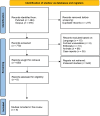The Role of the Urobiome in Kidney Transplantation: A Systematic Review
- PMID: 38769976
- PMCID: PMC11104728
- DOI: 10.1097/TXD.0000000000001643
The Role of the Urobiome in Kidney Transplantation: A Systematic Review
Abstract
Background: The urinary microbiome, also known as the urobiome, was traditionally considered sterile. However, emerging evidence suggests its presence in the urinary tract. Urobiome dysbiosis has been associated with various urologic conditions, making it a topic of interest also in kidney transplantation. This systematic review examines the evidence of urobiome changes in kidney transplant recipients (KTRs).
Methods: Systematic literature searches in the PubMed and SCOPUS databases.
Results: Of the 770 articles identified, 8 met the inclusion criteria. The urobiome showed reduced diversity in KTRs compared with healthy controls and patients on dialysis. Proteobacteria enrichment was associated with graft stability or spontaneous tolerance in KTRs without immunological events. Kidney interstitial fibrosis and tubular atrophy were associated with changes in resident urinary microbes and increased pathogenic bacteria. Additionally, KTRs with chronic allograft dysfunction had a higher prevalence of Corynebacterium.
Conclusions: The review highlights the importance of studying the urobiome in KTRs and its potential impact on transplant outcomes. The field remains largely unexplored, and further research is needed to establish consistent study designs and objectives. Future studies could lead to biomarker discovery, personalized therapies, and improved outcomes and graft survival in KTRs.
Copyright © 2024 The Author(s). Transplantation Direct. Published by Wolters Kluwer Health, Inc.
Conflict of interest statement
The authors declare no funding or conflicts of interest.
Similar articles
-
Rewriting the urinary tract paradigm: the urobiome as a gatekeeper of host defense.Mol Biol Rep. 2025 May 23;52(1):497. doi: 10.1007/s11033-025-10609-w. Mol Biol Rep. 2025. PMID: 40407923 Free PMC article. Review.
-
Current Evidence on Dietary Factors and Kidney Allograft Function in Kidney Transplant Recipients: A Systematic Review.Curr Med Chem. 2024;31(35):5818-5836. doi: 10.2174/0929867330666230515140454. Curr Med Chem. 2024. PMID: 37190815
-
Plasma Lead Concentration and Risk of Late Kidney Allograft Failure: Findings From the TransplantLines Biobank and Cohort Studies.Am J Kidney Dis. 2022 Jul;80(1):87-97.e1. doi: 10.1053/j.ajkd.2021.10.009. Epub 2021 Dec 4. Am J Kidney Dis. 2022. PMID: 34871698
-
A Child's urine is not sterile: A pilot study evaluating the Pediatric Urinary Microbiome.J Pediatr Urol. 2022 Jun;18(3):383-392. doi: 10.1016/j.jpurol.2022.02.025. Epub 2022 Mar 4. J Pediatr Urol. 2022. PMID: 35337731
-
Whole-Person, Urobiome-Centric Therapy for Uncomplicated Urinary Tract Infection.Antibiotics (Basel). 2022 Feb 9;11(2):218. doi: 10.3390/antibiotics11020218. Antibiotics (Basel). 2022. PMID: 35203820 Free PMC article. Review.
Cited by
-
Galla chinensis alleviated liver damage induced by acetaminophen by regulating intestinal microbiota.Front Microbiol. 2025 Jul 1;16:1589946. doi: 10.3389/fmicb.2025.1589946. eCollection 2025. Front Microbiol. 2025. PMID: 40666811 Free PMC article.
References
-
- Whiteside SA, Razvi H, Dave S, et al. . The microbiome of the urinary tract—a role beyond infection. Nat Rev Urol. 2015;12:81–90. - PubMed
LinkOut - more resources
Full Text Sources
Miscellaneous


